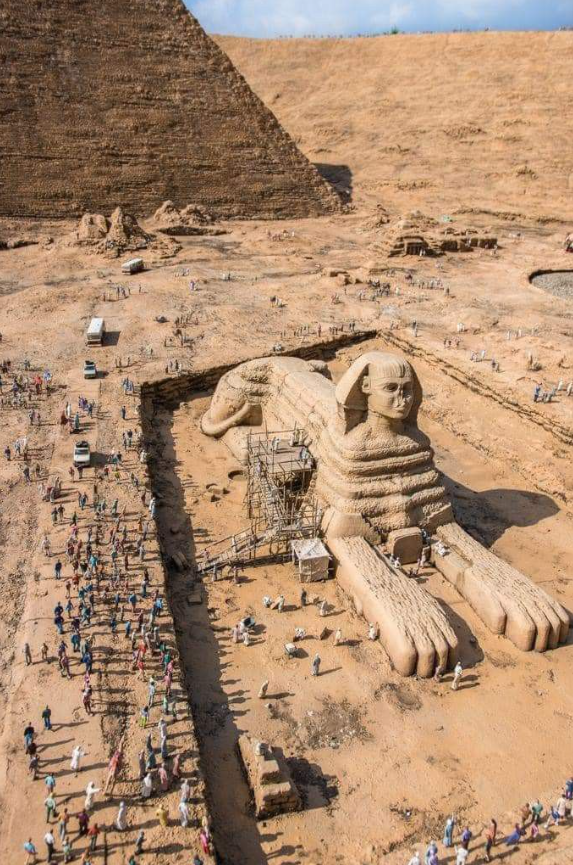The ancient Egyptian civilization has long fascinated people around the globe with its remarkable architectural prowess and innovative construction methods that allowed for the creation of massive and enduring structures. One of the most iconic of these is the Great Sphinx, a monument wrapped in intrigue, myth, and academic discourse. This article delves into the various theories regarding how the stone used in the Sphinx’s construction was carved and shaped, while also comparing its building techniques to those of other notable structures from ancient Egypt, including the pyramids and temples.
Introduction
The Great Sphinx, carved from a single limestone monolith, is among the most emblematic representations of ancient Egyptian artistry. Its mysterious features, merging the likeness of a human with that of a lion, provoke compelling questions about the craftsmanship techniques employed to achieve such detailed artistry. While the exact processes behind the Sphinx’s construction remain partly elusive, scholars have proposed multiple theories based on the examination of ancient tools and practices.
In addition to the technical side, the architectural characteristics of the Sphinx invite valuable comparisons with other significant Egyptian edifices. By contrasting the construction methods of the Sphinx with those used in the building of pyramids and temples, we can gain a richer insight into the expertise and innovative strategies utilized by ancient Egyptians in their monumental creations.
Techniques for Stone Carving and Shaping
The creation of the Sphinx demanded not only advanced architectural insight but also extraordinary stone-working capabilities. Below are some prominent theories regarding the methods used for carving, shaping, and finishing this remarkable monument.
Proposed Carving Techniques
- Use of Handmade Tools and Copper Instruments:
- Researchers suggest that ancient artisans used copper chisels, hammers, and other basic tools for the initial carving of the stone. Due to their relatively soft nature, copper tools were ideal for working with limestone, allowing for intricate detailing without excessive damage to the tools.
- Pros: Readily available materials and tools, combined with a painstakingly careful process that allowed for precision.
- Cons: Copper tools had limited durability, requiring frequent maintenance and replacement.
- Application of Abrasive Materials:
- Some theorists propose that ancient Egyptians could have created a mixture of sand or other abrasive materials with water to smoothed the surface of the stone. This approach facilitated the attainment of a fine, polished finish on larger areas.
- Process: This involved applying an abrasive slurry and then delicately rubbing the stone surfaces with leather straps or wooden implements.
- Utilization of Natural Fissures and Grain Patterns:
- Certain scholars believe that craftsmen may have leveraged natural cracks and grain lines in the limestone to assist in the carving process. By following these natural features, they could significantly lighten their workload when defining shapes.
- Implementation: Identifying and tracing the stone’s natural lines to help outline and define the contours of the Sphinx.
Stone Processing and Finishing
Once the initial carving was complete, extensive processing and finishing were required to provide the Sphinx with its final appearance.
- Sanding: The use of abrasive stones or rudimentary sanding tools allowed for the elimination of surface imperfections.
- Polishing: Vegetable oils and specific mixtures were applied for a glossy finish while also serving to protect the stone from erosion.
- Hand Detail Work: Every element of the Sphinx was carefully refined by hand to enhance its artistic attributes and ensure balanced proportions.
Restoration Techniques
Restoration is also crucial, given that the Sphinx has endured significant deterioration over the centuries. Modern restoration methods encompass:
- Laser Scanning: Enables precise detection of surface defects.
- Composite Materials: Utilized to reinforce vulnerable areas prone to crumbling.
- Ongoing Monitoring: Ensures timely preservation interventions to protect the monument.
Contrasting with Other Ancient Egyptian Structures
To truly appreciate the construction techniques employed in creating the Sphinx, it is beneficial to compare it with other landmark achievements from ancient Egypt, such as the pyramids and temples.
Pyramids
The pyramids, regarded as some of the most striking feats of ancient Egyptian architecture, were built using enormous stone blocks.
- Construction Techniques:
- Transportation: Large limestone blocks were transported via the Nile River and then moved using sledges and rollers.
- Assembly: Blocks were carefully fitted together utilizing basic yet effective tools.
- Layering: The construction process unfolded in horizontal layers, each demanding meticulous precision to sustain the overall geometry.
- Comparison to the Sphinx:
- Scale: The pyramids consist of vast volumes of stone, while the Sphinx is uniquely carved from a singular block.
- Techniques: Pyramid construction revolved around assembling pre-shaped stone blocks, whereas the creation of the Sphinx entailed intensive, singular processing of stone.
Conclusion
The construction of the Sphinx stands as a testament to the exceptional craftsmanship of ancient Egypt. It not only reflects advanced technological knowledge but also embodies the cultural, religious, and artistic values of its time. The combination of carving, processing, and polishing techniques used to create the Sphinx reveals a level of precision and attention to detail that remains awe-inspiring even today.
Key Takeaways:
- Technological Precision:
Ancient craftsmen combined hand tools with the natural properties of the stone to produce a unified monument. - Symbolism and Functionality:
The Sphinx acts as a guardian, a symbol of wisdom, and an eternal observer—characteristics that set it apart from structures like pyramids and temples. - Ancient Innovations:
The methods used in constructing the Sphinx not only illustrate engineering prowess but also reflect an in-depth understanding of aesthetic principles that influenced later architectural traditions.




